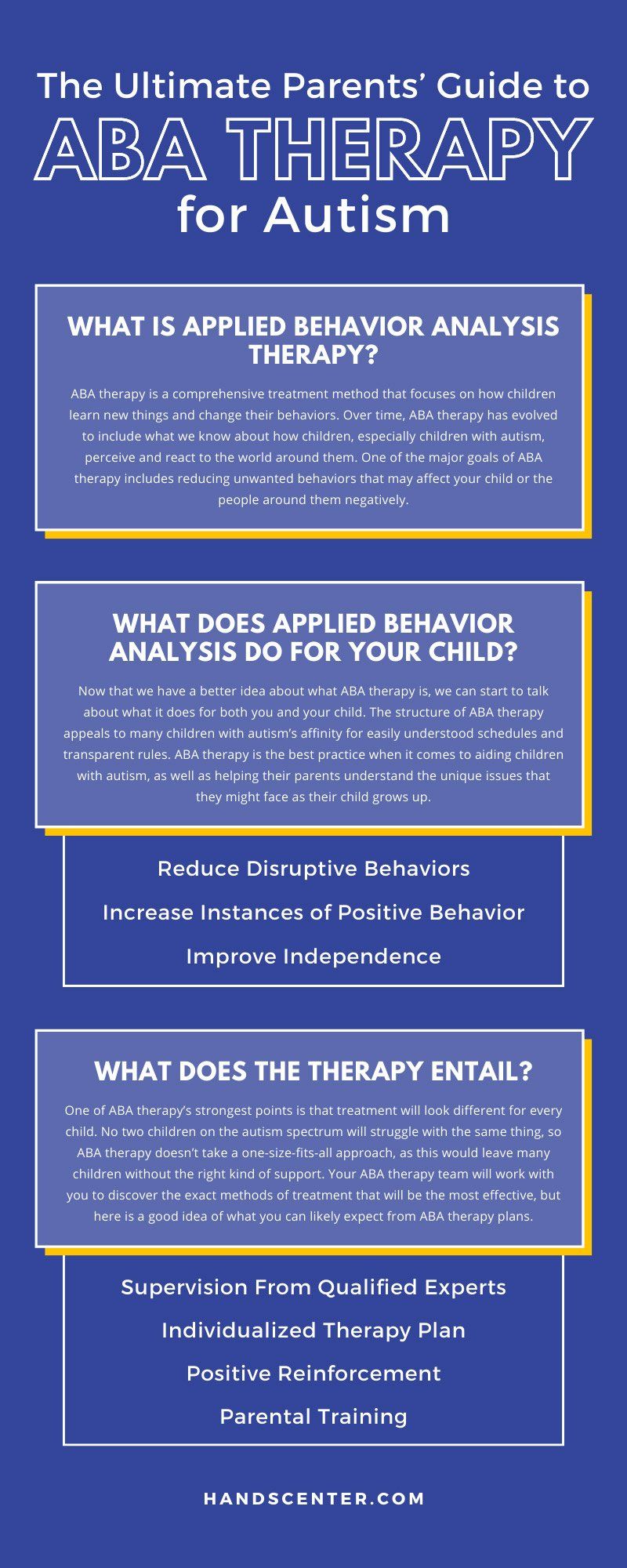The Ultimate Parents’ Guide to ABA Therapy for Autism
Every parent of a child with autism spectrum disorder wants to make sure that they can give them the best support they might need as they grow older. If you’ve recently found out that your child has autism spectrum disorder, it’s understandable that you might not know how to feel or what the next best step forward is. Here at the HANDS Center for Autism, we want every parent of every child with autism to feel like they can handle whatever comes their way and be there for their child through their toughest challenges.
For young children with autism, the best course of action to help them tackle the challenges they might face is through ABA therapy, or Applied Behavior Analysis therapy. This kind of treatment takes an individual approach to each child, discovering what their difficulties are and teaching them ways to handle those difficulties through positive reinforcement. This article will be the ultimate parents’ guide to ABA therapy for autism and serves as an introduction to what you and your child will see when you begin treatment.
What Is Applied Behavior Analysis Therapy?
ABA therapy is a comprehensive treatment method that focuses on how children learn new things and change their behaviors. Over time, ABA therapy has evolved to include what we know about how children, especially children with autism, perceive and react to the world around them. One of the major goals of ABA therapy includes reducing unwanted behaviors that may affect your child or the people around them negatively. It also provides a place where children with autism can work on their specific challenges in a safe space. Some of these challenges include things such as social skills, focus and attention in school or at home, independent life skills, and more.
What Does Applied Behavior Analysis Do for Your Child?
Now that we have a better idea about what ABA therapy is, we can start to talk about what it does for both you and your child. The structure of ABA therapy appeals to many children with autism’s affinity for easily understood schedules and transparent rules. ABA therapy is the best practice when it comes to aiding children with autism, as well as helping their parents understand the unique issues that they might face as their child grows up.
Reduce Disruptive Behaviors
Children with autism often have issues with not understanding why their problem behaviors are problematic. Behaviors such as crying throughout the night when they should be sleeping or interrupting others in the middle of conversation are things that plenty of children exhibit. However, children with autism often have a harder time ceasing these behaviors. ABA therapy can help you with techniques that mitigate these behaviors while also teaching your child why these behaviors are disruptive in the first place.
Increase Instances of Positive Behavior
ABA therapy is uniquely effective because it doesn’t focus on “stopping” behaviors we don’t want to see. Instead, it focuses on replacing those unwanted behaviors with newer and more productive behaviors that we want to see more of. Through reinforcement, your child will begin to learn which behaviors are OK, allowing them to more comfortably fit into different situations, whether they be by themselves or with others.
Improve Independence
Parents of children with autism often worry about their child’s ability to be independent. While every child with autism has a different level of independence that they can reach, getting them to that point can be difficult without ABA therapy. This treatment helps children maintain a better sense of self-control as they get older, which eventually becomes the skill of monitoring themselves and their own feelings without assistance.
What Does the Therapy Entail?
One of ABA therapy’s strongest points is that treatment will look different for every child. No two children on the autism spectrum will struggle with the same thing, so ABA therapy doesn’t take a one-size-fits-all approach, as this would leave many children without the right kind of support. Your ABA therapy team will work with you to discover the exact methods of treatment that will be the most effective, but here is a good idea of what you can likely expect from ABA therapy plans.
Supervision From Qualified Experts
The HANDS Center for Autism employs a wide range of experts in their fields to make sure that whatever your child needs help with, they have someone there who is well-versed in treating that particular issue. Our staff also has a wide range of experience working specifically with children of different age groups and knows how to change treatment plans according to individual needs.
Individualized Therapy Plan
As we’ve mentioned, your child won’t receive a cookie-cutter treatment plan when they start ABA therapy. As a parent, you’ll also play a large role in how they develop, and that starts by talking with you about your child’s specific challenges and goals that they will work on. This level of individual care is a cornerstone of good ABA therapy. We don’t want to work on issues that your child doesn’t have or neglect a particularly difficult behavior that you need help with.
Positive Reinforcement
ABA therapy focuses heavily on positive reinforcement to change unwanted behaviors and support good ones. Trying to change your child’s behavior through more punitive or harsh measures is cruel and doesn’t work as well for getting the desired outcome. ABA therapy focuses on rewarding the changes and behaviors we want to see while reframing unwanted behaviors in a manner that makes sense to your child.
Parental Training
As your child’s primary lifeline, they will go to you first when they have struggles or challenges that they don’t know how to handle. We want to make sure that you are never caught off-guard on how you can support them most effectively. ABA therapy includes extensive parent training as well, so you can continue the techniques we supply you with at home and out in public.
This ultimate parents’ guide to ABA therapy for autism is just the beginning. We encourage you to reach out to us if you have any questions about parent training for autism and how we can help your child. We hope that we can be a useful resource for you and your child in the future.







